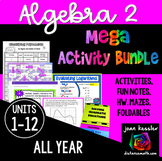Functions Key Properties, Zeros, and Graphs Bundle
- Zip
- Easel Activity
Products in this Bundle (7)
showing 1-5 of 7 products
Also included in
- This Algebra 2 Mega Bundle of Activities for Second Semester, Units 1 - 12, will keep your students engaged and learning, no matter which curriculum, text, or notes package you use. The large variety of quality activities are designed to reinforce your students' skills and also help you to easily dPrice $299.00Original Price $594.49Save $295.49
Description
This Graphs, Zeros, and Properties of Functions Bundle includes the following 7 resources.
- Graphs and Properties of Linear Functions
- Graphs and Properties of Quadratic Functions
- Graphs and Properties of Absolute Value Functions
- Graphs and Properties of Exponential Functions
- Graphs and Properties of Logarithmic Functions
- Graphs and Properties of Polynomial Functions
- Graphs and Properties of Rational Functions
Each individual resource has Organizers and Interactive Notebook pages. Some have blanks templates for you to personalize. Your students will graph the given functions, and determine key properties, such as increasing and decreasing intervals, vertices, turning points, asymptotes, multiplicity, zeros, symmetry, and more depending upon the function.
Please click on the links below to see the full descriptions. Each of these resources is also available in a Digital version. Click here.
____________________________________________________________
You may also like:
★ Graphs and Properties of Functions Digital Bundle
★ PreCalculus Curriculum Bundles
★ Piecewise Functions Maze, Matching, and Graphing
★ Parent Functions Comic Book FUN Note Bundle, great for doodling
★ Properties of Functions Foldable Flip Book
★ Library of 16 Functions Foldable Organizer
★ Graphs Your Students Must Know Matching
★ PreCalculus Bundle of 19 Activities
★ Graphing and Properties of Rational Functions DIGITAL Version
★ PreCalculus Curriculum Mega Bundle
__________________________________________________
Connect with me:
✓ Sign up at Joan's World of Math to access my exclusive Free Resource Library
✓ Visit my Facebook Page
✓ Follow me on Instagram
✓ Email me at: joan@joansworldofmath.com with any questions
LICENSING TERMS: The purchase of a license for this resource is for use by one teacher only for his or her students only. No part of this resource is to be shared with colleagues or used by an entire department, school, or district without purchasing the proper number of licenses.
COPYRIGHT TERMS: ©2024 Joan Kessler (joansworldofmath™). This resource may not be uploaded to the internet in any form, including classroom/personal websites or network drives, unless the site is password protected and can only be accessed by students.





